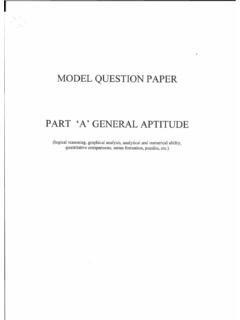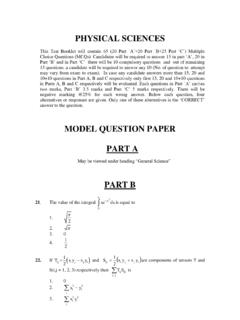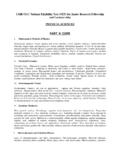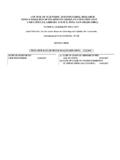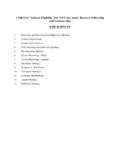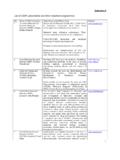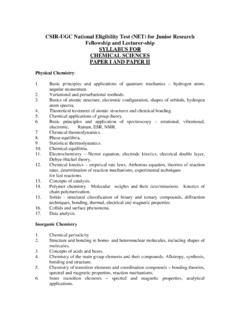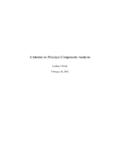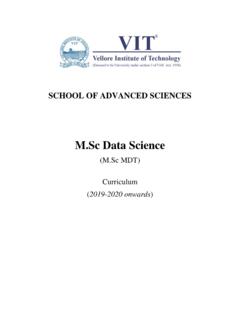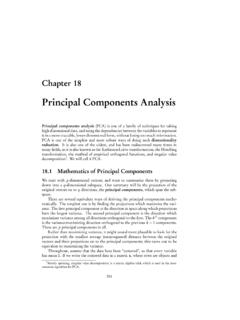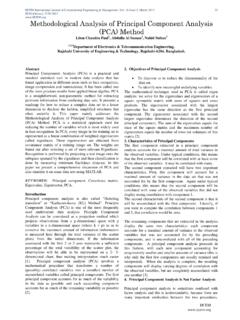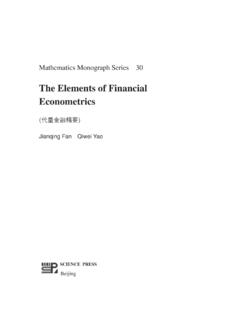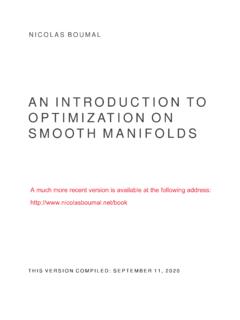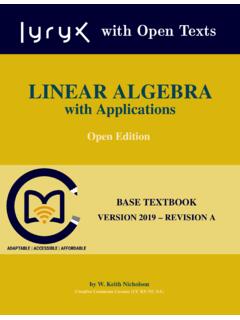Transcription of PROPOSED SYLLABUS FOR ‘Mathematical Science'
1 CSIR-UGC National Eligibility Test (NET) for Junior Research Fellowship and Lecturer-ship COMMON SYLLABUS FOR PART B AND C MATHEMATICAL SCIENCES UNIT 1 Analysis: Elementary set theory, finite, countabl e and uncountabl e sets, Real number s ystem as a complete ordere d field, Arc himede an propert y, s upremum, inf imum. Sequenc es and series, converg ence, limsup, liminf. Bolzano Weiers trass theor em, Heine Borel theorem. Continu ity, uniform continuity, differe ntiabi lity, mean value the or em. Sequenc es and series of func tions, uniform converg ence. Riemann sums and Riemann integra l, I mproper I ntegra ls. Monotonic functions, types of discontinuity, f unctions of bounded variation, Lebe sgue measure, Lebesgue integra l. Functions of severa l vari ables, directional deri vative, part ial deri vative, deri vative as a linear trans formation, invers e and implicit function theorems.
2 Metric spa ces, c ompactness, connectedn ess. Normed linear Spa ces. Spa ces of continuous functions as exa mples. linear algebra : Vector spaces, s ubspa ces, l inear depe nd enc e, basis, d imension, algebra of linear trans formations. algebra of matrices, r ank and determinant of matri ces, linear equations. Eigenv alues and eigenv ectors, Cayley- Hamilton theo re m. Matrix representation of linear tra ns formations. Chang e of ba sis, canonical f orms, diagonal f orms, triang ular f orms, Jordan forms. Inner product s pa ces, orthonormal basis. Qua dratic forms, redu ction and classification of quadratic forms UNIT 2 Complex Analysis: algebra of complex numbers , t he complex plane , polynomials, power s eries, trans cendental f unctions suc h as exp onentia l, trigonometric and hype rbolic functions.
3 Ana lytic functions, Cauchy-Riemann equations. Contour integra l, Cauc hy s theorem, Cauchy s integral f ormul a, Liouville s theorem, Maxi mum modulus princ iple, Schwarz lemma, Ope n mapp ing theor em. Taylor series, Laurent seri es, c alcul us of re sidues. Conformal mappings, Mobius trans formations. algebra : Permutations , c ombinations, p igeon-hole princ iple, inclusion-exc lusion principle, de ra ng ements. Fundamental theorem of ari thmetic, d ivisibility in Z, congruences, Chinese R emainder The orem, Euler s - f unction, primitive roots. Groups, s ubgroups, normal s ubgroups, quotient groups , homomorphisms, c yclic groups, permut ation groups, Cayley s theorem, class equ ations, Sylow theorems. Rings, ideals, prime and maxi mal ideals, quotient rings, unique factorization domain, principal ideal domain, Euclidean domain.
4 Pol ynomial r ings and irreducibility cri teria. Fields, f inite fields, f ield extens ions, Galois Theory. Topology: basis, dens e sets, s ubspace a nd product topology, s epara tion axioms, c onnectedness and compactness. UNIT 3 Ordinar y Diff erenti al Equations (ODEs): Existenc e and uniqueness of solutions of initial value problems f or first order ordina ry differe ntial equations, s ingular s olutions of first order ODEs, system of first order ODEs. Gene ra l theory of homogenous and non-homogene ous linear ODEs, v ariation of pa ra meters , Sturm-L iouville boundary value problem, Green s function. Par ti al Differenti al Equati ons (P DEs): Lagra ng e and Charpit met hods for solving first order PDEs, Cauc hy problem for first order PDEs. Classification of second order PDEs, Gene ral s olution of highe r order PDEs with constant coe ffi cients, Method of sepa ra tion of variabl es for Laplace, Heat and Wave equations.
5 Numerical Analysis : Numeri cal s olutions of algebraic equations, Method of ite ra tion and Newton-R aphson method, Rate of converg ence, Solution of systems of linear algebraic equations us ing Gaus s elimination and Gauss-Seidel methods, Finite differe nces, Lagra nge, Hermite and spline interpolation, Numerical differe ntiation and integra tion, Numeri cal s olutions of ODEs using Picard, Eul er, mod ified Euler and Runge-Kutta methods. Calculus of Variations: Vari ation of a functional, Euler-L agra nge equation, Necessary and sufficient conditions for extrema. Vari ational methods for boundary value problems in ordina ry and part ial diffe re nt ial e qu ations. linear Integral Equations: linear integral equation of the first a nd second kind of Fre dholm and Vol terr a type , Solutions with sepa ra ble kernels.
6 Characteri stic numbers and eigenfunctions , resolvent kernel. Classical Mechanics: Gene ra liz ed coordinates, Lagra ng e s equations, Hamilton s canonical equ ations , Hamilton s princ iple and principle of least a ction, Two-d imens iona l motion of ri gid bodies, Euler s dyna mical equations for the motion of a ri gid body about an axis, theory of small oscilla tions. UNIT 4 Descriptive statistic s, exploratory data analysis Sample space, discrete probability, independent events, Bayes theorem. Random variables and distribution functions (univariate and multivariate); expectation and moments. Independent random variables, marginal and conditional distributions. Characteristic functions. Probability inequalitie s (Tchebyshef, Markov, Jensen). Modes of convergence, weak and strong laws of large numbers, Central Limit theorems (i.)
7 Case). Markov chains with finite and countable state space, classification of states, limiti ng behaviour of n-step transition probabilities, stationary distribution, Poisson and birth-and-death processes. Standard discrete and continuous univariate distributions. sampling distributions, standard errors and asymptotic distributions, distribution of order statistics and range. Methods of estimation, properties of estimators, confidence intervals. Tests of hypotheses: most powerful and uniformly most powerful tests, likelihood ratio tests. Analysis of discrete data and chi-square test of goodness of fit. Large sample tests. Simple nonparametric tests for one and two sample problems, rank correlation and test for independence. Elementary Bayesian inference. Gauss-Markov models, estimability of parameters, best linear unbiased estimators, confidence intervals, tests for linear hypotheses.
8 Analysis of variance and covariance. Fixed, random and mixed effects models. Simple and multi ple linear regression. Elementary regression diagnostics. Logistic regression. Multivariate normal distribution, Wishart distribution and their properties. Distribution of quadratic forms. Inference for parameters, partial and multiple correlation coefficients and related tests. Data reduction techniques: Principle component analysis, Discriminant analysis, Cluster analysis, Canonical correlation. Simple random sampling, stratified sampling and systematic sampling. Probability proportional to size sampling. Ratio and regression methods. Completely randomized designs, randomized block designs and Latin-square designs. Connectedness and orthogonality of block designs, BIBD. 2K factorial experiments: confounding and construction.
9 Hazard function and failure rates, censoring and life testing, series and parallel systems. linear programming problem, simplex methods, duality. Elementary queuing and inventory models. Steady-state solutions of Markovian queuing models: M/M/1, M/M/1 with limited waiting space, M/M/C, M/M/C with limited waiting space, M/G/1. All students are expected to answer questions from Unit I. Students in mathematics are expected to answer additional question from Unit II and III. Students with in statistics are expected to answer additi onal question from Unit IV.
